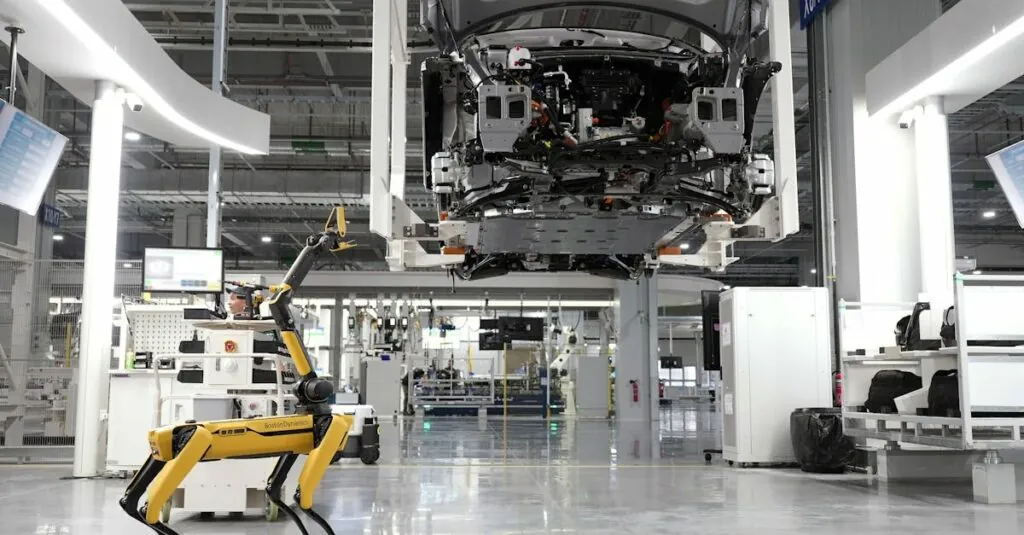Table of Contents
ToggleIn a world where everything from your toaster to your car is getting smarter, the Internet of Things Platform as a Service (IoT PaaS) is the unsung hero behind the scenes. Imagine a magical land where developers can whip up applications faster than a barista can brew your morning coffee. That’s the charm of IoT PaaS. It lets businesses connect devices and manage data without the headache of building and maintaining the infrastructure.
But wait, there’s more! With IoT PaaS, companies can scale their operations like a pro without turning into a tech circus. It’s all about simplifying the complex, making it easier for innovators to focus on what really matters: creating amazing experiences. So buckle up as we dive into the world of IoT PaaS and discover how it’s revolutionizing the way we connect, communicate, and control our devices.
Overview of IoT PaaS
IoT PaaS stands as a critical element in the realm of smart devices, streamlining the development of connected applications. This model enhances operational efficiency by allowing developers to focus on application creation, not infrastructure.
Definition of IoT PaaS
IoT PaaS, or Internet of Things Platform as a Service, provides a cloud-based environment for managing IoT applications. It enables developers to build, deploy, and manage applications without handling the complexities of underlying hardware and software infrastructure. By leveraging IoT PaaS, businesses gain access to integrated services and tools that facilitate data processing, device management, and application integration. These platforms support faster development cycles and innovation, ultimately driving the growth of IoT solutions.
Key Features of IoT PaaS
Key features of IoT PaaS significantly enhance its utility. These platforms often include device management, allowing users to monitor and control connected devices efficiently. Data analytics capabilities help interpret vast amounts of data generated by devices, delivering actionable insights. API support fosters seamless integration with existing systems, while scalability ensures resources adapt to varying demands. Additionally, security protocols safeguard data and maintain privacy, addressing critical concerns within IoT environments.
Benefits of IoT PaaS
IoT PaaS offers numerous advantages for businesses aiming to innovate and streamline their IoT applications. These benefits include scalability and flexibility as well as cost efficiency.
Scalability and Flexibility
Scalability plays a pivotal role in adapting to changing demands. Businesses can seamlessly expand or reduce resources based on their needs. Flexibility allows developers to quickly integrate new features and services without significant delays. Leveraging a cloud infrastructure, IoT PaaS enables organizations to accommodate fluctuating workloads effortlessly. Many platforms also support diverse devices and protocols, enhancing compatibility across the IoT ecosystem. This adaptability empowers companies to innovate swiftly, responding to market changes and user feedback.
Cost Efficiency
Cost efficiency remains a key advantage of adopting IoT PaaS solutions. Companies can significantly reduce expenses related to hardware and maintenance through cloud infrastructure. Reduced capital expenditures mean organizations can invest more in development and innovation processes. By utilizing a subscription-based model, businesses only pay for what they use. This model provides predictable budgeting, essential for financial planning. Moreover, IoT PaaS often includes built-in analytics and monitoring tools, reducing the need for additional software purchases and minimizing operational costs.
Use Cases of IoT PaaS
IoT PaaS offers a range of applications across various sectors. Its versatility empowers businesses to harness the full potential of connected devices.
Smart Cities
Smart cities leverage IoT PaaS for enhanced urban management. Real-time data collection allows for improved traffic control and resource allocation. Sensors monitor air quality and manage public services effectively, optimizing energy consumption. Additionally, smart waste management systems use IoT PaaS for efficient waste collection, leading to cleaner environments. Integration of connected devices facilitates intelligent lighting, which adjusts based on pedestrian movement, reducing energy usage. All these features contribute to making urban living more sustainable and efficient.
Industrial IoT
Industrial IoT utilizes IoT PaaS to optimize manufacturing processes and improve operational efficiency. Predictive maintenance becomes simpler with real-time monitoring of equipment health. This proactive approach reduces downtime by identifying potential failures before they occur. Data analytics enable manufacturers to analyze production patterns, leading to smarter resource allocation and waste reduction. Furthermore, IoT PaaS integrates various machinery, creating a cohesive system that enhances communication and coordination on the factory floor. Enhanced visibility into supply chains allows for better management of logistics and inventory, ultimately driving cost savings and productivity increases.
Leading IoT PaaS Providers
Numerous IoT PaaS providers stand out in the market, offering various features tailored to different business needs. Analyzing these options helps organizations select the most suitable platform for their requirements.
Provider Comparison
AWS IoT is a frontrunner, delivering comprehensive services for device connectivity and data processing. Google Cloud IoT excels in real-time data analytics and machine learning capabilities. Microsoft Azure IoT Hub offers strong integration with existing Microsoft services, benefiting enterprises deeply invested in that ecosystem. IBM Watson IoT stands out for its advanced analytics and security features that protect sensitive data. This comparison highlights crucial strengths among leading providers, ensuring informed decisions for businesses entering the IoT domain.
Strengths and Weaknesses
AWS IoT boasts scalability and vast service options but presents a steep learning curve for newcomers. Google Cloud IoT’s powerful analytics tools enhance decision-making, yet pricing can become complex with extensive usage. Microsoft Azure IoT Hub provides excellent integration flexibility but may lack specific features available in specialized platforms. IBM Watson IoT offers robust security but can face limitations in user interface friendliness. Each provider showcases unique strengths and weaknesses, guiding businesses in navigating the IoT landscape efficiently.
Challenges and Considerations
Organizations adopting IoT PaaS encounter several challenges that require careful consideration. Addressing these challenges ensures successful implementation and management of their IoT solutions.
Security Concerns
Security remains a primary issue for IoT PaaS. Protecting sensitive data from unauthorized access demands robust cybersecurity measures. Weaknesses in IoT devices can create vulnerabilities across the entire network. When data is transmitted between devices, interception poses significant risks. Frequent software updates and strong encryption protocols support enhanced security. The complexity of managing security across interconnected devices further complicates the landscape. Compliance with regulations such as GDPR and HIPAA adds another layer of responsibility for businesses. Therefore, integrating comprehensive security strategies is vital for system integrity.
Integration Issues
Integration issues often hinder seamless operations in IoT PaaS. Connecting diverse devices and platforms can present compatibility challenges. Different protocols and data formats may result in difficulties when transferring information. Additionally, legacy systems often resist integration with newer technologies, causing operational delays. Ensuring that all components communicate effectively requires thorough planning. Project management resources must focus on smooth integration across various environments. Custom APIs and middleware solutions can bridge gaps between systems and enhance functionality. Consequently, successful integration streamlines processes and improves overall efficiency.
Conclusion
Embracing IoT PaaS is essential for businesses looking to thrive in a rapidly evolving digital landscape. By leveraging its capabilities, organizations can streamline operations and focus on innovation while minimizing infrastructure costs. The ability to scale and integrate diverse devices enhances overall efficiency and responsiveness to market demands.
As industries continue to adopt smart technologies, IoT PaaS stands out as a vital enabler of connected solutions. With careful consideration of security and integration challenges, companies can harness its full potential to drive growth and enhance user experiences. The future of IoT is bright, and IoT PaaS is at the forefront of this transformation.




